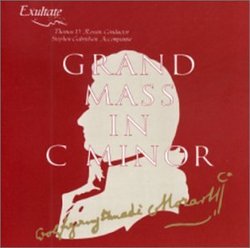| All Artists: Exultate Festival Choir & Orchestra Title: Grand Mass in C Minor Members Wishing: 1 Total Copies: 0 Label: Exultate Original Release Date: 5/1/2001 Release Date: 5/1/2001 Genre: Classical Style: Number of Discs: 1 SwapaCD Credits: 1 UPC: 659552109121 |
Search - Exultate Festival Choir & Orchestra :: Grand Mass in C Minor
 | Exultate Festival Choir & Orchestra Grand Mass in C Minor Genre: Classical
Mozart began work on the Mass in C Minor in the summer of 1782. To fulfill a promise to Constanze he would perform a Mass in her honor when he took her to Salzburg to meet his father, who had not given the marriage his ble... more » |
Larger Image |
CD Details
Synopsis
Product Description
Mozart began work on the Mass in C Minor in the summer of 1782. To fulfill a promise to Constanze he would perform a Mass in her honor when he took her to Salzburg to meet his father, who had not given the marriage his blessing. The Mass was rehearsed on August 23rd, and performed in the Benedictine Abbey of St. Peter on August 26, 1783 with Constanze herself singing one of the solo soprano parts. The next performance did not occur until April 3rd of 1901. The score was published from incomplete materials in 1840. The Kyrie, Gloria, most of the Sanctus, including the Osanna and the Benedictus, were finished, but regarding the Credo we find only Credo in unum Deum and Et incarnatus est. In this performance the Credo ends after the text, Holy Spirit of the virgin Mary, and wasmade man. The remaining portion of the second article as well as the entire third article of the creed are missing. On this recording we have chosen to present the incomplete mass. The Agnus Dei is a reworking of the Kyrie and was not in the original score. We include it here for two reasons. First, it rounds out the Mass by using a technique often used by composers, that of having the same or similar music at the beginning and the end of a composition and secondly, it makes the Mass somewhat more complete. By including an Agnus Dei we at least have portions of all five parts of the Mass. There is evidence that Mozart intended to finish the work but his life ended less than 10 years later and the composition remained unfinished alongside the also unfinished Requiem Mass. The Mass in C Minor is the most ambitious and elaborate of Mozart¹s church works, planned on a scale comparable to that of Bach's Mass in B minor. At the very time Mozart was writing it, he was also studying the works of Johann Sebastian Bach. It is evident in the counterpoint and basic structure of this mass that Mozart was impressed with the works of Bach and was influenced by his hearing of Bach's compositional style. Because of that the Grand Mass is the single most elaborate, complex and difficult of all the Mozart vocal works. In this one composition we see a different Mozart, a supreme composer who is most mature and most accomplished in his craft of placing notes on paper. What a wonderful treasure it is!

 Track Listings (13) - Disc #1
Track Listings (13) - Disc #1